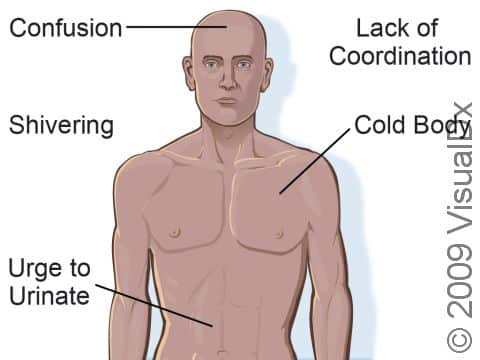Hypothermia, First Aid
Hypothermia results when a person’s internal body temperature drops below normal due to cold exposure. Hypothermia starts with mild symptoms but can progress and potentially become life-threatening. A person experiencing a late stage of severe hypothermia may go into a coma or suffer cardiac arrest.
Who's At Risk?
Hypothermia occurs most often to those exposed to extreme cold, so people who participate in cold-weather outdoor activities or who live in or travel to cold climates are at risk.
Infants are most likely to become hypothermic, particularly if they sleep in a cold bedroom. Older adults, people who are ill, and people with poor circulation are at an increased risk of hypothermia. Additionally, certain diseases and medications, alcohol consumption, and smoking increase the risk for hypothermia.
Signs & Symptoms
Signs of mild hypothermia include shivering, confusion, lack of coordination, the urge to urinate, and a cold body (even in body locations that are usually warm, such as the armpits). In infants, signs of mild hypothermia include cold, red skin and lethargy.
Signs of severe hypothermia include a person who is very cold but not shivering, very uncoordinated, drowsy, weak, confused, and possibly uncooperative or irrational. Additionally, the person may have slurred speech and vision loss. In the late stages of hypothermia, the person may be unconscious and have stiff muscles.
Assume that anyone who has been pulled out of cold water (eg, someone who fell through ice) has hypothermia.
Self-Care Guidelines
First Aid Guide:
When hypothermia is suspected, seek medical care. While awaiting medical services:
- Check the person’s airway, breathing, and circulation (ABCs).
- Move the person to a warmer area, and replace any wet or constricting clothes with loose, dry clothing.
- To rewarm the person, based on the means available, try any combination of the following:
-
- Cover the person completely with foil or a space blanket, or use your own body heat to help warm them.
- Use warm compresses on the neck, chest, and groin.
- Give warm, sweet fluids. (Any fluids given should be nonalcoholic, as alcohol interferes with the blood’s circulation.)
Note: When a person has both frostbite and hypothermia, contact emergency medical services, and give first aid for the hypothermia followed by first aid for the frostbite.
Treatments
The medical professional will initiate basic life support measures, if necessary, including resuscitation and cardiac monitoring. If the person’s core temperature is below 86°F (30°C), rewarming may need to be done before any therapy for cardiac arrest is effective.
Severe hypothermia may necessitate warm intravenous (IV) fluids; warm, humid oxygen; and/or other warming measures.
Visit Urgency
For mild hypothermia, perform the above self-care measures and then obtain medical help. For severe hypothermia, call emergency medical services immediately.
Trusted Links
Last modified on August 9th, 2024 at 12:08 pm

Not sure what to look for?
Try our new Rash and Skin Condition Finder
